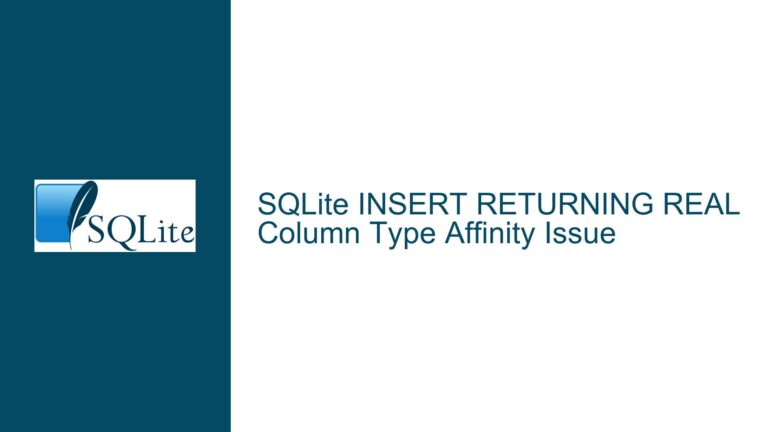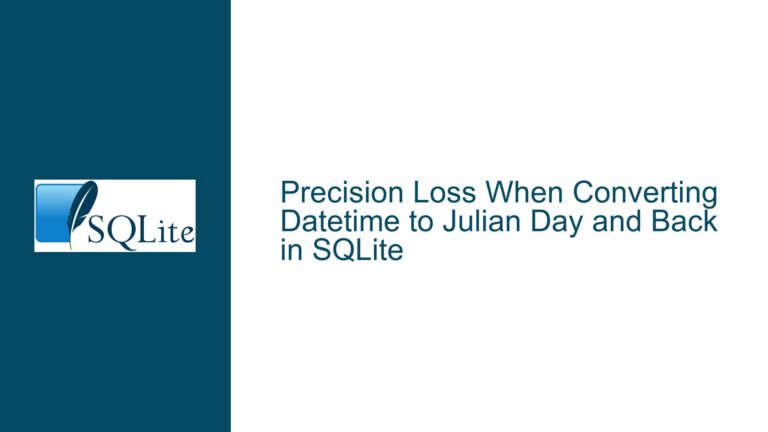SQLite WAL Mode Reader Isolation: Committed Changes Not Visible Across Connections
Issue Overview: Understanding Visibility of Committed Changes in WAL Mode
SQLite’s Write-Ahead Logging (WAL) mode is designed to allow concurrent read and write operations by maintaining separate snapshots of the database state for each connection. However, this concurrency model introduces specific visibility rules that can lead to scenarios where committed changes from a writer connection are not immediately observable to reader connections. The core issue arises from SQLite’s strict adherence to transaction isolation principles, particularly the snapshot-based visibility model in WAL mode.
When a writer connection executes an INSERT OR REPLACE operation (or any data modification) and commits the transaction, the expectation is that subsequent reads from other connections will reflect the updated state. In reality, reader connections may continue to observe outdated data if their transactions began before the writer’s commit. This behavior is not a bug but a deliberate design choice to ensure transactional consistency. SQLite guarantees that a connection’s view of the database remains stable for the duration of its transaction, even if other connections modify the data.
The problem is exacerbated in applications with long-running read transactions or unmanaged prepared statements. For example, a reader connection that executes a SELECT query and retains an open iterator (e.g., a Rust rusqlite::RowIterator) will maintain a read transaction for the lifespan of that iterator. Any writes committed after the iterator’s creation will remain invisible to that connection until the iterator is finalized and a new transaction begins. This behavior aligns with SQLite’s "serializable" isolation level, which ensures that transactions operate on a consistent snapshot of the database.
Possible Causes: Transaction Boundaries, Prepared Statements, and Checkpointing
The primary cause of invisible committed changes lies in transaction lifecycle management. SQLite connections in WAL mode operate under the following critical constraints:
Transaction Snapshots and Isolation:
Each read transaction in SQLite captures a snapshot of the database at the moment the transaction begins. In WAL mode, this snapshot includes the contents of the main database file and the WAL file up to the last committed write at the time of the snapshot. If a reader connection starts a transaction (explicitly viaBEGINor implicitly via aSELECT), it will not see changes committed by other connections after its snapshot was taken. This is true even if the writer usesBEGIN EXCLUSIVE, as exclusivity pertains to write locks, not read visibility.Unfinalized Prepared Statements and Iterators:
A prepared statement or an active query iterator (common in ORM layers or Rust’srusqlitelibrary) implicitly holds a read transaction open. For example, a long-runningSELECTquery that streams results via an iterator maintains a read transaction until the iterator is dropped or the statement is reset. During this period, the connection cannot see new commits from other connections because its transaction is still active. This is often overlooked in application code, especially when using higher-level abstractions that manage iterators or cursors.Checkpointing and WAL File Retention:
Although the user disabled automatic checkpointing (wal_autocheckpoint=0), manual checkpoints do not directly affect read visibility in WAL mode. Checkpointing transfers data from the WAL file to the main database file, but readers using WAL mode always read from the combined state of the main database and WAL. However, if a reader connection was opened before a checkpoint and has an active transaction, it may continue to reference the pre-checkpoint WAL data, creating the illusion of outdated results. This is rare but possible in edge cases with extremely long-lived connections.
Troubleshooting Steps, Solutions & Fixes: Ensuring Consistent Read Visibility
Step 1: Audit Transaction Boundaries and Iterators
Examine all reader connections for open transactions or long-running iterators. In Rust’s rusqlite, ensure that iterators are explicitly finalized using Iterator::finalize() or by scoping them within a limited block. For example:
{
let mut stmt = conn.prepare("SELECT * FROM table")?;
let rows = stmt.query_map([], |row| { /* ... */ })?;
// Process rows here; iterator is dropped at the end of the block
}
// New transactions after this point will see latest commits
If a long-running SELECT cannot be avoided (e.g., for batch processing), consider splitting the operation into smaller transactions or using sqlite3_snapshot APIs (if available in your SQLite build) to coordinate reads and writes.
Step 2: Enforce Explicit Transaction Control
Avoid relying on SQLite’s autocommit mode for read operations. Instead, explicitly manage read transactions with BEGIN and COMMIT to control snapshot boundaries. After a writer commits changes, ensure readers commit their current transactions (if any) and start new ones:
// Reader connection
reader.execute("COMMIT", [])?; // End current transaction
reader.execute("BEGIN", [])?; // Start new transaction with latest snapshot
For rusqlite, leverage the Transaction trait to scope transactions:
let tx = reader.transaction()?;
// Perform reads within this transaction
tx.commit()?; // Explicitly commit to release the snapshot
Step 3: Validate Prepared Statement Lifecycles
Ensure all prepared statements are reset or finalized when not in use. A lingering prepared statement can hold a read transaction open, blocking visibility of new commits. Use rusqlite’s Statement::finalize method or scope statements within a block to guarantee cleanup:
let rows = {
let mut stmt = conn.prepare("SELECT * FROM table")?;
stmt.query_map([], |row| { /* ... */ })?
};
// `stmt` is finalized here, releasing its transaction
Step 4: Reassess Checkpointing Strategy
While manual checkpointing is not directly related to read visibility, aggressive checkpointing can reduce WAL file size and minimize the risk of readers referencing outdated WAL data. Use PRAGMA wal_checkpoint(TRUNCATE) after bulk writes to merge WAL changes into the main database. However, prioritize transaction management over checkpoint tuning, as checkpointing does not resolve snapshot isolation issues.
Step 5: Use Read-Uncommitted Mode (If Acceptable)
For applications that prioritize read latency over strict consistency, enable read-uncommitted mode using PRAGMA read_uncommitted = 1; on reader connections. This allows readers to see changes from uncommitted writer transactions but does not bypass snapshot isolation for committed changes. This is a niche solution and does not address the core issue of transaction boundaries.
Step 6: Monitor Long-Running Queries
Instrument application code to log the duration of queries and transactions. In rusqlite, enable tracing or use middleware to detect long-lived iterators. For example:
conn.trace(Some(|sql| println!("Executing: {}", sql)));
Combine this with metrics collection to identify transactions that outlive expected timeframes.
Final Recommendation
The root cause of invisible commits is almost always an open read transaction on the reader connection. Rigorously manage transaction lifecycles, avoid long-running iterators, and prefer explicit transaction control over autocommit behavior. In Rust, leverage the type system and scoping rules to enforce timely cleanup of statements and transactions.






